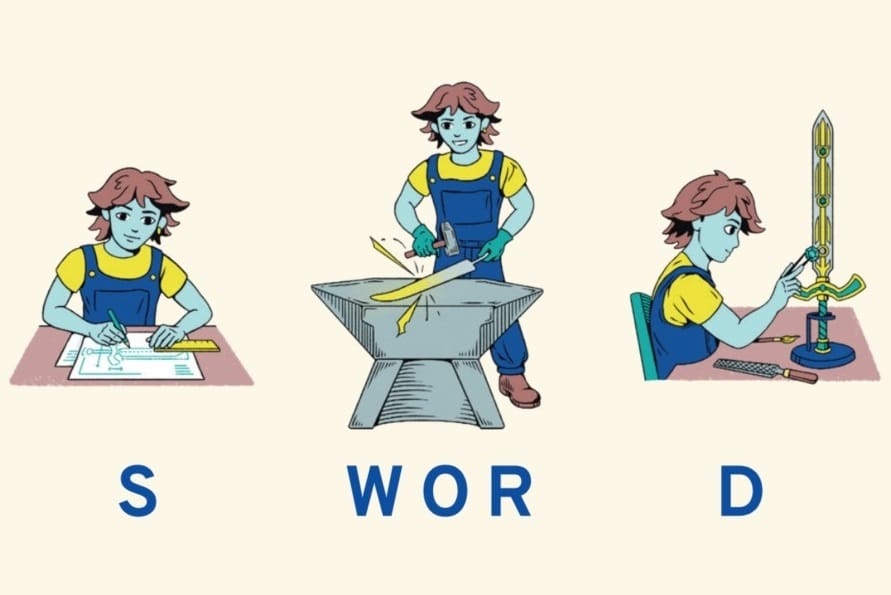Scientific writing:
the SWORD method
“The pen is mightier than the sword”, famously wrote Edward Bulwer-Lytton, an English author of the 19th century. And yet somewhat ironically, Agent Majeur did forge a method for writing called SWORD, the ultimate weapon to help you write clear and compelling scientific documents. This method, taught during our training courses in scientific writing, consists in three steps: plan the structure, write and improve the language, and polish the layout of your documents. Step by step, SWORD will help you to hone your writing skills.

The specific requirements of scientific writing
Scientific writing brings its share of unique challenges. When you write, you need to stay aware of what your readers can or cannot understand. But you must also consider why your audience will read the document and why your work is important to them. Most often, you will write about very specific subjects. If your readers are other specialists in your field, they will have the necessary expertise to understand the topic and its jargon.
If, however, you are addressing the general public or scientists from other disciplines, you will need to adapt. Because these readers have a different level of knowledge. For example, when a scientist describes a method for cooling a turbine blade, a number of people will not understand what it’s about, why that’s important, nor the stakes involved.
What is the SWORD writing method?
The SWORD method for scientific writing is a guide. It will help you to write convincing scientific documents adapted to your audience. The principles of this method work for any type of document: a research article, a PhD thesis, a report, a funding application, a narrative CV or even a blog article.
To write a compelling document, it is important to ask yourself the right questions in the right order. For example, if you begin writing without preparing your plan beforehand, you will likely feel writer’s block or end up procrastinating. Furthermore, if your ideas are not structured, your content will be confusing and/or it will require a significant amount of time-consuming modifications and corrections.
Like any good recipe, you need to follow the SWORD method step by step. If you do, informing and convincing your readers, regardless of their level of knowledge, will become a piece of cake.
What are the three steps for the SWORD method?
« SWORD » is an acronym for the three steps that we recommend you follow when you write your scientific documents: Structure, WORding and Design.
1/ S for Structure
The first step consists in preparing the “Structure” of your message. Begin by defining the context of your research. Then, clarify your main message. In just a few words, your message sums up what your audience needs to remember after reading the document.
Finally, find a logical plan to organize your ideas and arguments. In some cases, you can have a lot of flexibility for some documents. For others, like scientific papers or study reports, you will need to follow the conventional structure: title, abstract, introduction, material & methods, results, discussion, conclusion and finally, references.
To build your plan, we advise you to use mind-mapping. This tool makes it possible to organise your ideas in a visual way. Rather than beginning with the top of the page and filling it with sentences or lists, place the main message in the centre. The different ideas will revolve around this main topic and you will not lose sight of the thread.
2/ WOR for language (Wording)
The second step, “language”, will focus on your writing skills. You should favour short and simple sentences. A simple sentence begins with a subject, followed by a verb and a complement, if possible in this order. Furthermore, simple sentences will only include a limited number of words. Ideally, a sentence should not be longer than 20 to 25 words. Where possible, try to write in the present tense.
Use a direct style: write in active voice instead of passive voice, use positive rather than negative turns of phrase. Also, avoid using subordinate clauses and relative pronouns. For example, « the demonstration which follows » can be replaced by « the following demonstration ». Finally, keep in mind that you may need to popularise your work. Adapt your written content to your audience and their level of understanding. If your readers have no knowledge whatsoever, avoid using jargon words or define them.
3/ D for layout (Design)
The third step, “design”, refers to the visual aspects of your communication. It is important to use scientific illustrations (e.g. tables, figures, schemas, graphs) but also photos or videos, to illustrate your work. A neat and beautiful layout and design will make your content more attractive and more importantly, it will make it easier to read. Keep in mind that white space is a key ingredient. For example, in the case of paragraphs, white space will allow readers to detach information, understand each block of ideas, and reflect on what they have just read. White space will also help readers to find the information they are seeking in the document and to pick and choose the elements which interest them.
Finally, do not overlook proofreading, to correct any grammar or spelling mistake, before you widely disseminate your document. A scientific document must be rigorous in both form and substance. Several methodical proofreading sessions will generally be necessary to produce quality content.
Using the SWORD method
Start to write a few weeks, or at least a few days before the deadline, even in the case of a short article. That way you will have time to reflect on the content and carefully correct the text. Never send a document you have just finished to your colleagues. Let it rest for at least one night, to read it again with a fresh mind the next day. Patience is a virtue, and slow and steady wins the race!
> Written communication
26/03/2024



